News

The Basics of Knot Tying
The Basics of Knot Tying: Essential Knots for Sailors and Everyday Use
Knot tying is an essential skill, not only for sailors but for anyone who finds themselves needing to secure, bind, or tow objects. We’ll explore five fundamental knots: the clove hitch, half hitch, bowline, figure 8, and reef knot. We'll define each knot, explain its uses, and highlight their importance both on and off the water.
Firstly, why is knot tying important to sailors?
For sailors, knot tying is a vital skill. Proper knots ensure safety and efficiency on the water. They secure sails, moor boats, tie down equipment, and perform rescue operations. The right knot can mean the difference between a smooth sail and a dangerous situation.
Catch our short video on how to tie each knot here.

1. Clove Hitch
Definition: The clove hitch is a simple knot that consists of two successive half-hitches around an object. It is easy to tie and untie and can be adjusted quickly.
Uses: The clove hitch is commonly used for securing a rope to a post, tree, or another fixed object. It's particularly useful when setting up tents, hanging items, or securing fenders to the rails of a boat.
Importance to Sailors: Sailors frequently use the clove hitch because it's quick to tie and easy to adjust. It's ideal for tasks that require frequent repositioning of ropes.
2. Half Hitch
Definition: The half hitch is one of the simplest knots, involving a single loop that is passed around an object and then through itself.
Uses: Often used in conjunction with other knots, the half hitch is primarily employed to secure the end of a rope. It can be used to start or finish a knot.
Importance to Sailors: In sailing, the half hitch is valuable for quickly securing loose ends of ropes and making temporary ties.
3. Bowline
Definition: The bowline forms a fixed loop at the end of a rope. It is known for its strength and reliability, and it won't slip or jam under load.
Uses: This knot is ideal for creating a secure loop for mooring lines, towing, and rescue operations.
Importance to Sailors: The bowline is a critical knot for sailors due to its reliability and strength. It's used to secure sails, tie off dinghies, and create loops that won't tighten under tension.
4. Figure 8
Definition: The figure 8 knot, named for its shape, is a strong and easily recognisable stopper knot. It prevents ropes from slipping through a hole or pulley.
Uses: It is often used to prevent the end of a rope from unravelling and can be used as a foundation for more complex knots.
Importance to Sailors: Sailors use the figure 8 knot to stop lines from running out of control through blocks and to provide a secure stopper at the end of ropes.
5. Reef Knot (Square Knot)
Definition: The reef knot, also known as the square knot, consists of two overhand knots tied in opposite directions, making it symmetrical and secure.
Uses: It's commonly used to tie two ropes together or to secure bandages and packages.
Importance to Sailors: Sailors rely on the reef knot for its ability to join two ropes of the same thickness securely. It's often used for reefing sails and tying down equipment.
These knots are not just confined to nautical use. The skills learned from knot tying can be applied in various everyday scenarios:
- Clove Hitch: Tying down a surfboard to a car roof rack.
- Half Hitch: Securing loads or garden tools.
- Bowline: Towing a car or securing a pet's leash.
- Figure 8: Preventing ropes from slipping or fraying.
- Reef Knot: Tying packages or bundles.
Mastering these basic knots can enhance your safety and efficiency, whether you're sailing the open seas or tackling tasks at home. By understanding the purposes and applications of each knot, you can choose the right one for any situation, ensuring that your knots are both secure and effective.
